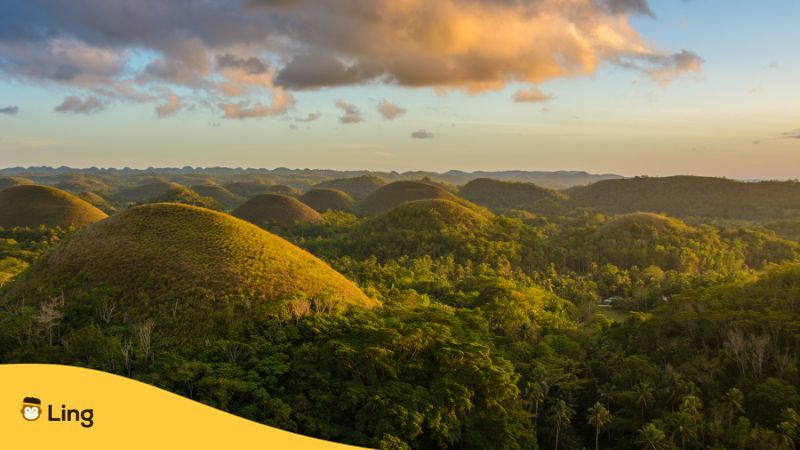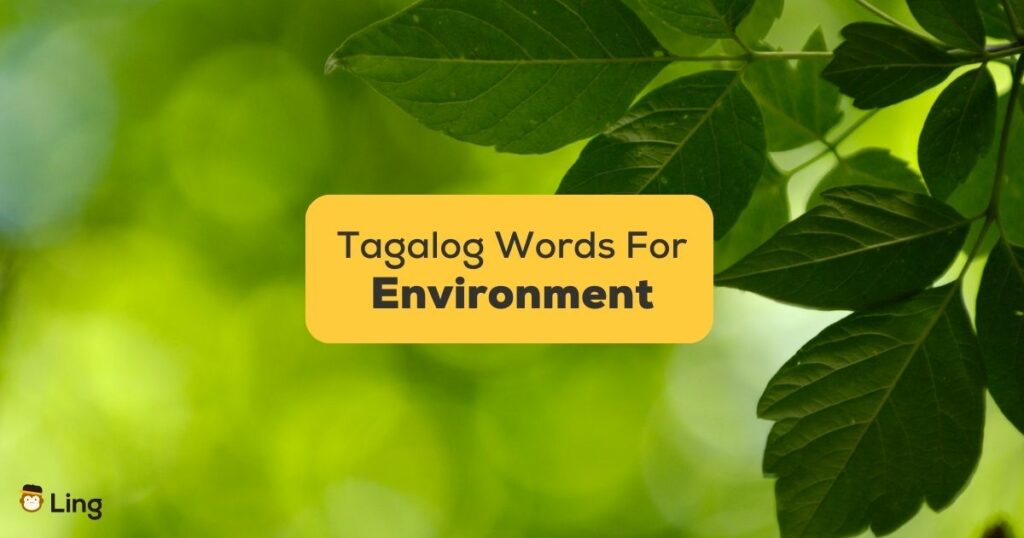Imagine standing amidst the lush, emerald jungles of the Philippines, where the symphony of nature’s melodies surrounds you. As the gentle breeze rustles the leaves and sunlight filters through the dense canopy, you’re reminded of the profound connection between language and the environment. In the heart of this island nation, Tagalog—its official language—offers a unique portal into the world of nature.
Join us in this article and discover Tagalog words for the environment. From the high and massive ‘bundok’ (mountain) to climate change, we will learn with fun and with a newfound love for nature!
What Is ‘Environment’ In Tagalog?
In Tagalog, ‘environment’ is translated as ‘kapaligiran’—a general term that tackles environment. But it doesn’t stop there; it has synonyms! You can say ‘kalikasan’ for a more direct regard to nature, for example. Moreover, to be really specific, there is the word ‘kagubatan’ to describe the forest environment, and ‘karagatan’ for the marine environment. Yep, Tagalog has its own collection of words to describe certain parts of nature.
Picture this: pristine and white sand beaches, emerald jungles, and critters you won’t find anywhere else on Earth. That’s the Philippines’ kalikasan—a real-life treasure hunt for nature lovers! The Philippines is an archipelago of over 7,000 dazzling islands, each one like a puzzle piece, fitting together to create this wonderland of biodiversity. You’ve got rainforests teeming with life, coral reefs bustling with color, and wildlife that has rare animals like tarsiers and tamaraws!

Basic Tagalog Words For The Environment
Now that you know ‘kapaligiran’ and ‘kalikasan,’ prepare yourself, as we are going to learn more Filipino words about them. Ready? Let’s go!
Plant – Halaman
First on our list is ‘halaman’ (plant)! Halaman in the Philippines is a vibrant, essential part of life. These living artworks come in all shapes and sizes, adding color to gardens and flavor to dishes. They’re eco-heroes, producing oxygen and uniting communities. Moreover, some people treat their halaman as if it were their pet or even their child! We call those types of people ‘plantita’ (plant aunt) and ‘plantito’ (plant uncle).
Tree – Puno
Next is Puno, or trees. These are the towering giants that define the landscape. They provide shade and fresh air, and serve as homes to various wildlife—like the famous tarsier and Philippine eagle! These eco-superheroes combat climate change and are vital to the country’s environment. In other words, Puno aren’t just trees; they’re nature’s majestic pillars of life.
Water – Tubig
Water is directly translated as ‘tubig’ in Tagalog. It quenches your thirst and hosts aquatic life. Amazingly, tubig is very accessible in the Philippines because of the bodies of water surrounding it. Also, rain is very common—averaging around 144 days per year, providing more than enough supply of tubig!
Air – Hangin
I don’t mean to point out every element like in Avatar, but our next Tagalog word is ‘hangin’, which means air in English. Hangin is the invisible force that surrounds us. It’s the breeze that cools, the wind that plays, and the breath of life itself.
One thing about the Philippines is that it is so hot! It is one of the sun’s favorite hangout spots. That’s why a cool breeze of hangin is the most refreshing thing to experience outdoors at noon. That said, though hangin is unseen, it’s an essential and delightful part of everyday life in the Philippines.

Sun – Araw
‘Araw,’ the sun in the Philippines, is our radiant life force. It graces us with its warm embrace, powers our homes through solar energy, and paints breathtaking sunsets over our stunning landscapes! Though the sun can be harsh sometimes, especially around 12-3 p.m. in the Philippines, its importance for sustaining nature is undeniable.
Animal – Hayop
Next are nature’s entertainers, which are animals, or ‘hayop.’ From the wild jungles to the depths of the ocean, they’re a diverse and fascinating cast of characters, from cheeky monkeys to graceful dolphins. But hayop can also be scary, like lions and tigers. Nevertheless, a hayop is not only a magnificent creature but also a source of food for us.
Climate – Klima
From sunny beach days to surprise rainbows and the occasional typhoon tango, klima (climate) keeps life in balance. It is also a year-round adventure in the Philippines. Speaking of year-round adventure, the Philippines only experiences two seasons: rainy (tag-ulan) and sunny (tag-araw).
Deforestation – Kawalan Ng Kagubatan
In the Philippines, Kawalan Ng Kagubatan, or deforestation, is a warning signal. It disrupts our forest symphony, endangers wildlife, and impacts our climate and water supply. But it’s also an opportunity for change. Planting ‘puno’ (trees) is one of the ways to improve, showing that we can rewrite our environmental story for a greener future.
Climate Change – Pagbabago Ng Klima
Last on our list is Pagbabago Ng Klima, or climate change, which is like a weather rollercoaster. It brings rising temperatures, intensified storms, and coastal challenges. Moreover, this answers the confusion about unexpected and unseasonal rains and droughts. Solving this requires global efforts. That’s why we must do our best and take care of our ‘mundo’ (earth).
Learn Tagalog With Ling
That’s all, folks! These are the Tagalog words associated with our surroundings. Let us remember to keep our love and care for our kalikasan so that the next generations may enjoy it, too.
Did this article pique your interest in learning more about Tagalog? I highly encourage you to do it with Ling! Why?
The Ling app is your passport to Tagalog language mastery, and it’s like having a language wizard in your pocket! Say goodbye to boring textbooks and hello to fun, interactive lessons that make learning Tagalog feel like an adventure. With bite-sized lessons, quizzes that feel like games, and lessons created with native speakers, it’s like a language party every day.
So, whether you’re craving conversations with locals, diving into Tagalog culture, or just impressing your friends with Tagalog jokes, the Ling app is your secret weapon. Get ready to level up your Tagalog skills, and have a blast doing it!
Download it now for free on the Apple App Store or Google Play Store!



































































